In B2B marketing, one of the primary roles of marketing is to bring prospects to the door of your house. The role of the demand generators (we will call them SDRs for convenience) is to open the door and bring them into the house. The role of sales is to close the deal.
SDRs and ABM are a magical combination. In this article, we will dive into how ABM can boost the SDR team’s effectiveness and how intent data can improve SDR’s life.
I want to give a massive shout-out to Ben Person, martech entrepreneur and the former CMO of Nuvolo, for his insights in writing this post. Ben has forgotten more about this topic than I will ever know.
SDRs and ABM – Your Secret Weapon
In an account-based marketing model, SDRs are critical. Marketing resources are focused more on a narrower set of targets. Each lead is even more likely to be a good fit than traditional B2B marketing, as the account has been targeted more precisely with personalized content based on their interests and current activity. Each lead is even more precious, so getting these leads over the metaphorical threshold is even more important.
A strong alignment between marketing and sales is the key to a successful ABM program. And more importantly, marketing and the SDRs need to work seamlessly together. In many organizations that have embraced ABM, the SDRs are part of the marketing organization to ensure complete alignment between the group.
Using ABM can also be transformative in how effectively your SDRs perform. Let’s look at life for SDRs with and without ABM, and let’s start with the situation without ABM.
Being an SDR Without ABM
What’s the day like for an SDR that comes into a new SaaS company that is not using ABM?
To start with, they have poorer intelligence in their outreach activities besides the traditional tools like social media and data sources like Zoominfo. The challenge is how to make the SDRs’ jobs easier and make them more successful in increasing those conversions from marketing leads into opportunities and revenue.
And so, let’s start with a little bit of a story from Ben Person, the former CMO of Nuvolo.
“So before ABM, what did we do? We had a team of SDRs, and they would define the target market, and the ideal customers we wanted to call into, and then they would start their outreach. They’d go into Salesloft and begin their outreach and targeting. The challenge with that is all of those outreaches, for the most part, are completely cold. They would use templated email and phone scripts written by product marketing and polished by marketing writers. But even with those standard talking points, they were sending those messages to potentially a non-engaged buyer. We don’t know if they’re in a buying cycle or currently looking for information that the SDR is sending. We don’t know what that buyer is currently using, evaluating, or even interested in. For us, that is as cold as outreach gets. They don’t even know our company exists in many cases.”
How ABM Changes The Way an SDR Works
In a situation where ABM has been implemented effectively, the life of an SDR looks very different. When is ABM running, it will feel like you are delivering automated awareness and movement to get buyers interested based on the topics they’re investigating and getting them to convert into a lead. For the SDR, this means that SDRs spend more time calling into a person with interest and intent, and they’re calling in with real data about that buyer.
For example, the SDR will know what content the prospect is engaging with, what topics they are researching, how long they are on your website, and what competitors they’re looking at.
Once you have ABM up and running, your SDRs will be armed with the key intel to set them up for success in their outreach. If the marketing team has done its job well, the buyer will have been targeted with content that is relevant to that particular buyer. So when a phone call or email comes into that potential client, they already know the company exists and why they are reaching out. They have already seen relevant information they have been researching, which was valuable to them.
As a buyer, you are more likely to be ready to speak with an SDR, and when an SDR does reach the buyer, the buyer is better informed and more engaged.
SDRs have much more control over the process. It feels like a more deliberate 5-step approach.
- Start by building targeted brand awareness.
- Get the best-fit accounts engaged through digital channels
- Use intent data to determine who is in-market
- Score them based on engagement with your content
- When they show enough intent, have your SDRs pursue them using the intent data gathered throughout the process.
You can’t just turn on an ABM campaign and expect that SDRs can start calling tomorrow. You need to warm up the buyers and filter out the accounts not currently in a buying cycle. First, you see intent; then, you start to put ads in front of them for an entire month. As the intent increases and there’s more interest, your SDRs should begin their follow-up. And you will need to cycle through different topics and segmentations to engage unresponsive target accounts. Below is a visual of what an ABM and SDR combined plan could look like.
As a marketer, your objective is to ensure that you have enough of the right accounts with the right information at the right time so that when your SDRs are outreaching, they have an improved hit rate.
SDRs are typically compensated based on their ability to create new customer meetings and generate opportunities and a sales pipeline. By introducing ABM to your SDR, you positively affect their ability to make more commission and increase the company’s bottom line revenue.
A Quick Way To Introduce ABM to Your SDRs
One of the simplest uses of intent data is to provide in-market reports to your sales team, especially SDRs. This can be achieved by integrating the source of intent data with your CRM. This can become a critical dashboard for the SDRs. A well-designed dashboard combines intent surge data with company website engagement. It creates a “Spike Heat” signal that indicates which companies are most actively in-market and engaging with them. Ideally, your ABM dashboard will aggregate and visualize all the data to allow marketing, SDRs and Sales to operate from the same playbook as they prioritize their targeted outreach.
In a recent project with a client, we used Zoominfo intent data with a client and saw positive results within a week. Their SDR team was researching current customer intent for a relatively new service that they were offering, e.g., Remote Patient Monitoring (RPM). The head of the SDR team saw that a very large current customer was showing intent for RPM but still needed to purchase it from them. She alerted the account team, and within a few days, they reached the right person at the customer, who said they were about to start an RFP process and would be included.
If you are thinking about piloting intent data with your SDRs, let us know how we can help. We have a ton of experience in this area and a real passion for helping them get working with it.
Originally posted on LinkedIn.

